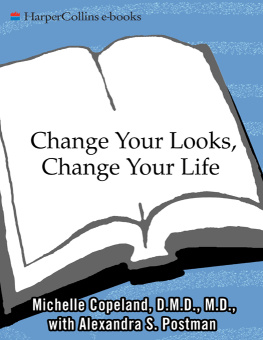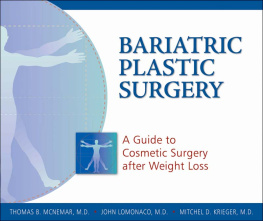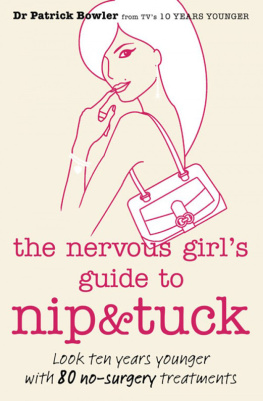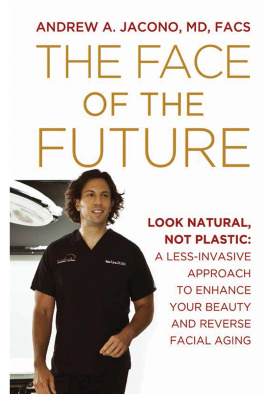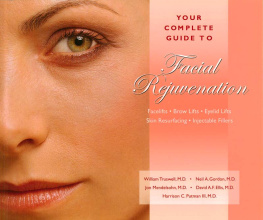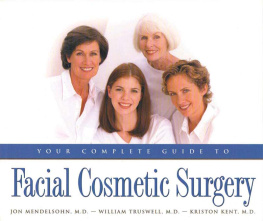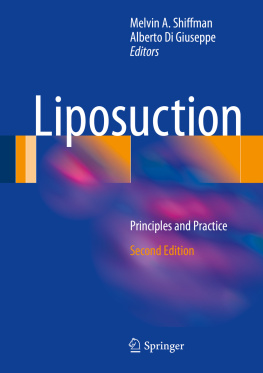This book became a reality with the assistance of many good friends, whose encouragement and guidance helped me navigate the literary maze. Delia Marshall and Candy Lee urged me on from the beginning and were there whenever I seemed to waver. My thanks as well to my literary agent, Mark Reiter, who believed in the concept from the start; to Diane Reverand, who brought it to HarperCollins; and to Susan Friedland for making it happen. Most of all, Im deeply grateful to Alex Postman, who performed the magic of transforming clinical experience and the movements of a surgeons hands into prose.
WHAT IF?
W ere a culture that imagines and embraces possibility. What if we could actually change? What if we could genuinely improve ourselves? What if we could look better than we ever haveor ever thought we couldand still remain true to ourselves? What if? is the idea behind this book.
Helping people imagine how their looksand, by extension, their livescan improve is the most challenging and rewarding part of my daily work. In my twenty years practicing as a plastic surgeon, Ive met hundreds of women and men who come to my office wanting to change something : the violinist, spirited and vivacious as a forty-five-year-old, whose skin betrays her sixty-five years; the fifty-year-old computer executive with bags under his eyes who fears losing a deserved promotion to a younger co-worker; the thirty-seven-year-old single mom who repeatedly breaks off promising relationships because shes scared to get naked with a new partner. The effect their appearance has on their self-confidence is more than skin-deep; it has enormous impact on their emotional health, the quality of their lives, and their future outlook.
TODAYS REVOLUTION IN COSMETIC SURGERY
I have been privileged to witness the self-image of so many patients undergo extraordinary and dramatic changes, even after minor work. And Ive come to see how cosmetic surgery can be a powerful, and empowering, tool; its reach extends beyond flattening a stomach or removing a deep-creased scowl or smoothing pitted skin. It can help to restore energy and optimism, to give that literal lift needed to make more far-reaching physical and, ultimately, psychological improvements.
Back in the early 1970s, when I was one of the few women in my class at Harvard Medical School (and the first to graduate with a dual degree in dentistry and plastic surgery), the discipline of plastic surgery was in its infancy. It had only recently shifted from its long-standing focus on reconstructive surgery (fixing cleft palates and badly broken noses, for instance) to cosmetic (or aesthetic) surgery, the practice of doing for people what nature didnt or couldnt. We who specialized in cosmetic surgery performed massive, Hollywood-style face-lifts and experimented with such new body-sculpting procedures as liposuction; the results, while encouraging, were less than stellar. As technology improved, we were able to make even more dramatic changes on patients who needed or wanted them.
Today, we have entered a kind of Golden Age of plastic and cosmetic surgery: In just the last half-decade, medical advances have greatly reduced the invasiveness, risk, pain, and recovery time of most procedures, radically transforming what the profession can do. No longer must every fix and its aftermath be anxiety-ridden, painful, or time-consuming. New techniques like these have contributed to advances in the field:
- Twilight sleep puts patients in a deeply relaxed state without the debilitating grogginess of general anesthesia. Patients walk out of my office on their own just a couple of hours after a procedure.
- Endoscopic surgery, which uses a long, thin tube attached to a video camera, allows me to perform such procedures as a forehead lift with only three tiny incisions behind the hairline, rather than the old ear-to-ear headband incision that leaves a nasty scar. Recovery time? Three days, versus three weeks.
- Liposuction, first introduced in the 1980s, has improved to the point where we can now remove large amounts of fat from all over the body, all at once, without causing the blood loss and massive bruising and swelling that used to be routine. And large-scale surgical procedures such as tummy tucks, neck lifts, and arm lifts are now often eschewed in favor of lipo, which in many cases tightens and flattens skin just as effectively with virtually no scarring.
- Small-incision surgery means shorter, better-placed, and quicker-to-heal scars for almost all procedures. A face-lift used to require a long, winding incision from the temple area, under the ear, and into the hairline. Now I usually opt to do a mini-lift, requiring a much shorter, and less visible, incision. Another example: Breast reductions used to incur a three-part scar, with the longest section in the breast crease. Today, I resort to this traditional method only when breasts are far too big to support one of the smaller-scar alternatives: an incision around the nipple, or one around the nipple and down to the breast crease. Not only do smaller incisions minimize scarring, but with a quicker recovery they are good news for those who must return to normal life as quickly as possible after surgery.
- Many new techniques achieve superb results without surgery. For example, I may opt to forgo a face-lift and instead perform a series of minor procedures without putting someone under the knife. Collagen or fat injections in the face strategically plump it up; while microdermabrasion, a painless process in which a steady stream of fine crystals is sprayed at the skin, dramatically buffs and tightens the skins surface, especially in combination with light lasers, which stimulate new collagen growth.
In short, what were once major surgeries are now outpatient procedures that can be done in my office, during lunchtime.
THE ART OF SCIENCE: A WOMANS TOUCH
Scientific progress is only part of what defines my job. Over the yearsand very much with the help of my patientsIve come to see that plastic surgery is an art. If Im a scientist first, then I must be an artist second. And I learned this because I listen: My patients share their wishes and concerns; along with my fellow surgeons, I use the increasingly adaptive technology at my fingertips to express what is unique and beautiful about each person, and I attempt to do this creatively and sensitively.
Let me repeat something I just said: I express what is unique and beautiful about each person . That is it, in a nutshell. In recent years, surgeons have become more educated in the subtleties of beautyreal-life, individual beauty, not the cookie-cutter perfection we associate with the oft-lifted, tucked, and bobbed. And weve grown much better at sculpting human beings.
Why? Frankly, I think its because of the rising number of women plastic surgeons in the field.
That sounds sexist, I know. But I can testify to how things used to be, and they werent pretty. I had a hard time becoming a plastic surgeon. In the 1970s, when it came to giving women an equal chance, even Harvard was less than enlightened. On the first day of anatomy class, the professor projected on the screen a slide of a Rubenesque naked woman. Pretty much everyone but me (one of only a couple of women in the class) hooted at her voluptuous curves. Today, those former medical students are out in the world, shaping noses, recontouring thighs, enlarging or reducing breastsin short, helping to define beauty. And many of those male surgeons tend to style their idea of the perfect womanlike so many Pygmalions. The problem with that? The ideal that guides men is often a far cry from female standards of beauty.

